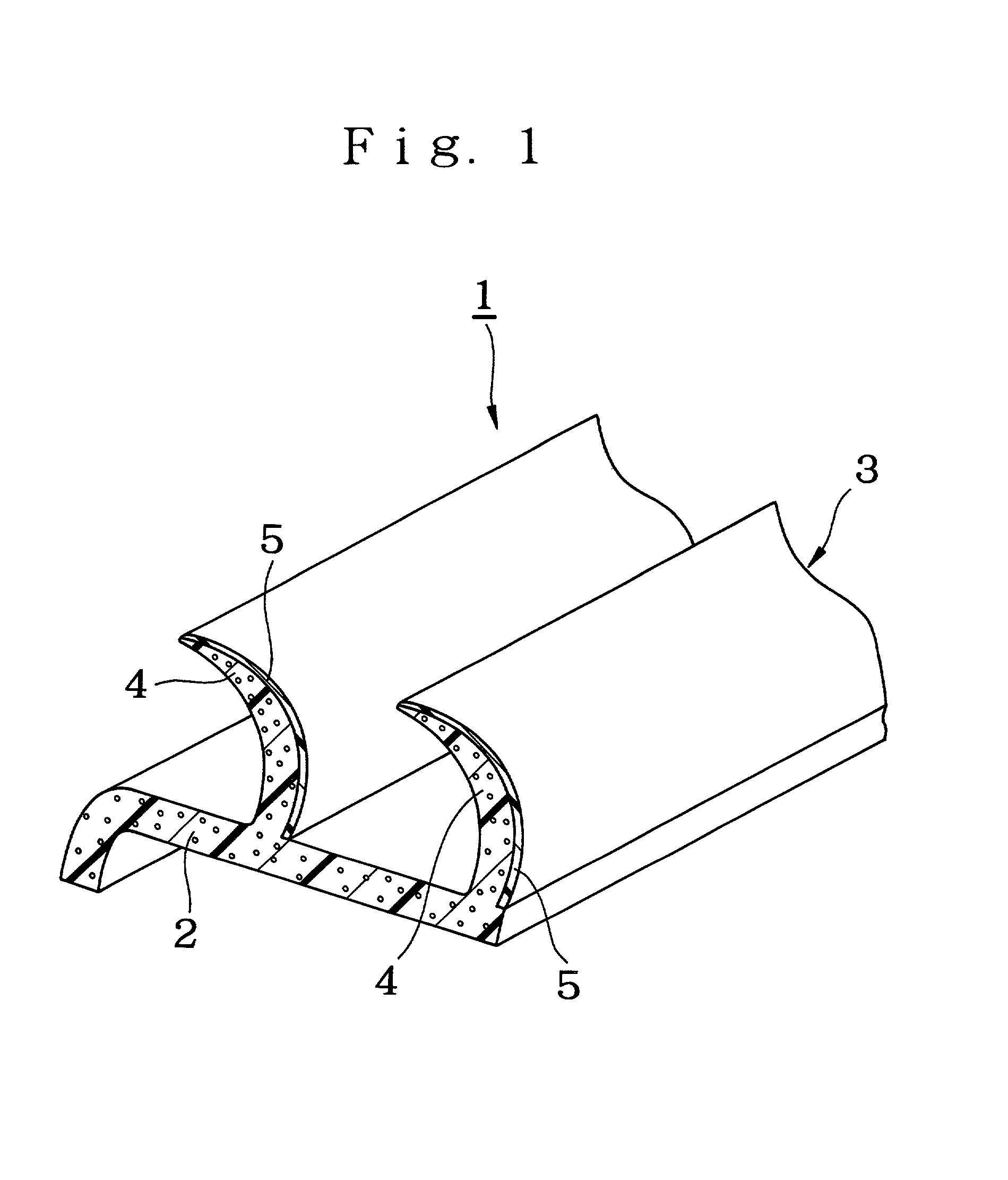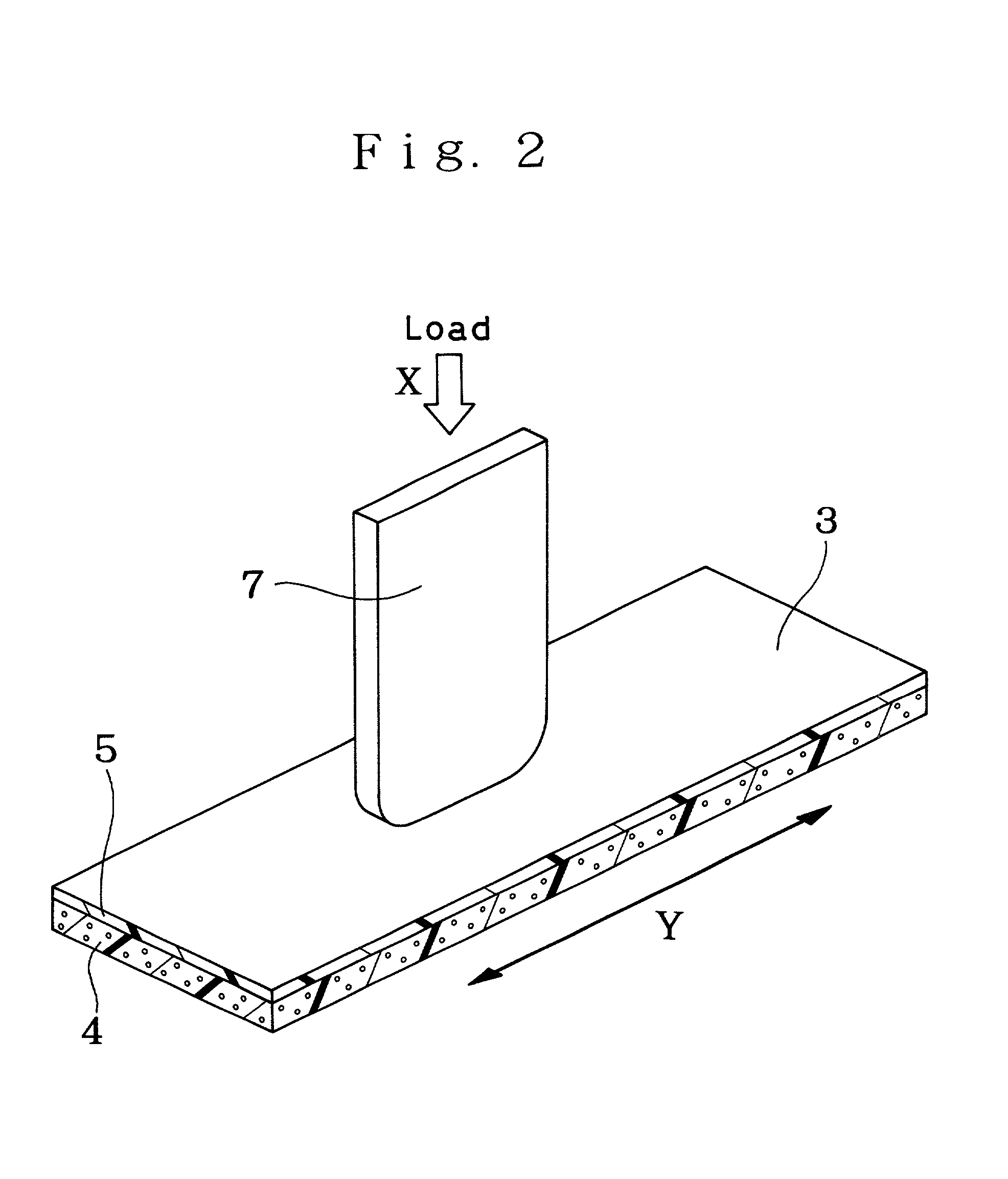Layered product olefin foam and use
a technology of foaming and layered products, applied in the field of foaming laminate, can solve the problems of inferior appearance, low foaming expansion ratio of foamed articles, and inconvenient us
- Summary
- Abstract
- Description
- Claims
- Application Information
AI Technical Summary
Problems solved by technology
Method used
Image
Examples
example 1-1
(1) Production of the Ethylenic Thermoplastic Elastomer (A-1)
[0336]There were blended on a Henschel mixer 30 parts by weight of a linear low density polyethylene (density=0.920 g / cm3, MFR=2.1 g / 10 min., ethylene content=97.0 mole % and 4-methyl-1-pentene content=3.0 mole %) and 70 parts by weight of an ethylene / propylene / dicyclopentadiene copolymer rubber (ethylene content=77 mole %, Mooney viscosity ML1+4 (100° C.)=145 and iodine value=12). Then, on a double shaft extruder having an L / D of 30 and a screw diameter of 50 mm, a dynamic heat treatment was effected at 220° C. under a nitrogen atmosphere and the resulting mass was extruded to produce a pelletized product of an ethylenic thermoplastic elastomer (A-1). A cylindrical test specimen of a thickness of 12.7 mm and a diameter of 29.0 mm was prepared from the resulting ethylenic thermoplastic elastomer (A-1) by injection molding, wherefor compression set was observed (JIS K 6262, 70° C., 22 hours), which resulted in a value of 46...
example 1-2
[0341]Using 30 parts by weight of the linear low density polyethylene as used in Example 1-1, 70 parts by weight of the ethylene / propylene / dicyclopentadiene copolymer rubber as used in Example 1-1 and 40 parts by weight of a softening agent based on mineral oil (a product of Idemitsu Kosan Co., Ltd. with trademark PW-380, a paraffinic oil), an ethylenic thermoplastic elastomer (A-2) was obtained in the same way as in Example 1-1. For the resulting ethylenic thermoplastic elastomer (A-2), compression set and MFR were determined in the same manner as in Example 1-1. A compression set of 46% and an MFR of 4 g / 10 min. were observed.
[0342]Then, using this ethylenic thermoplastic elastomer (A-2), a foamable composition was prapared in the same way as in Example 1-1, from which a weather strip was produced together with the skin layer same as that prepared in Example 1-1. For this weather strip, a durability test was performed. This weather strip had withstood 50,000 repetitions of up-and-...
example 1-3
[0343]Using 15 parts by weight of the linear low density polyethylene as used in Example 1-1, 85 parts by weight of the ethylene / propylene / dicyclopentadiene copolymer rubber as used in Example 1-1 and 20 parts by weight of a propylene / ethylene random copolymer (PP-1) (MFR=0.5 g / 10 min., ethylene content=4 mole %), an ethylenic thermoplastic elastomer (A-3) was prepared in the same manner as in Example 1-1. For the resulting ethylenic thermoplastic elastomer (A-3), compression set and MFR were determined in the same way as in Example 1-1. A compression set of 55% and an MFR of 2 g / 10 min. were observed.
[0344]Then, using this ethylenic thermoplastic elastomer (A-3), a foamable composition was prepared in the same way as in Example 1-1, from which a weather strip was produced together with the skin layer same as that prepared in Example 1-1. For this weather strip, a durability test was performed. This weather strip had withstood 50,000 repetitions of up-and-down motion and maintained ...
PUM
| Property | Measurement | Unit |
|---|---|---|
| Temperature | aaaaa | aaaaa |
| Temperature | aaaaa | aaaaa |
| Temperature | aaaaa | aaaaa |
Abstract
Description
Claims
Application Information
 Login to View More
Login to View More - R&D
- Intellectual Property
- Life Sciences
- Materials
- Tech Scout
- Unparalleled Data Quality
- Higher Quality Content
- 60% Fewer Hallucinations
Browse by: Latest US Patents, China's latest patents, Technical Efficacy Thesaurus, Application Domain, Technology Topic, Popular Technical Reports.
© 2025 PatSnap. All rights reserved.Legal|Privacy policy|Modern Slavery Act Transparency Statement|Sitemap|About US| Contact US: help@patsnap.com



